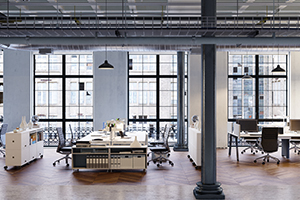The age of the cube farm is over. What about the commercial office itself?
Though many businesses were able to manage the past year remotely, in-person work isn’t going anywhere. It’s not a question of if business will get done in the office. Instead, it’s a question of what that office will look like.
Now comes the harder part.
Be honest: were your employees excited to return to the office?
Were you?
Remote work had its pitfalls, but as a stress test, it has helped to clarify what our offices do well, need to do better, and could do without. And after a year locked at home, if your employees dread returning to the office, it may be time to rethink your office.
How can you make your office a place that facilitates productivity and collaboration?
As a Commercial Real Estate (CRE) brokerage and developer, the DRK Realty team has thought A LOT about offices. What does a good office need—and what distinguishes a great one. We at DRK wanted to share a few principles that help guide our design philosophy.
Specificity

- The design studio pictured here has been built to facilitate this firm’s specific tasks. This space efficiently houses resources for every stage of the production process—from sales documentation to inspiring art books to drafting equipment—without creating clutter.
Not so long ago, economies of scale inspired designers, office suppliers and developers to push for modularity. What workplaces saved in office expenses they often lost in character—one can only skin the same cat so many times, after all. Not only can generic equipment feel boring and sterile: it’s often wasteful. Your office should be task-oriented in design: what do your employees actually need to do each day? How can you design a space that makes those tasks easier?
There is another downside to “general purpose” design. Put simply, the jack of all trades is a master of none. The challenge for designing your office, then, is balancing specificity and our next principle.
Flexibility

- This office takes advantage of an open floorplan, movable furniture and lush indoor plants to create a multipurpose gathering space that can be either part of or apart from the rest of the office. With minimal rearrangement, it can host a team meeting and serve as an interviewee waiting area—all in the same afternoon.
Why should a room have only one function? Rather than letting meeting spaces sit idle most of the day, design in multifunctionality. While this will take different forms at every company, the key is to design spaces with multiple anticipated uses and with high adaptability, for whatever forms of collaboration are necessary in your workplace setting.
Functionality

- This office’s quirky meeting areas illustrate how efficiency and personality don’t have to be enemies. The value of your square footage is maximized not only by paring down, but also by building out where it creates value. Engagement, collaboration, and rejuvenation facilitated by this nook boost employee morale and productivity.
Trim the fat—and ONLY the fat. This principle is what helps to reconcile the specificity-flexibility tension, because functionality embraces the wisdom of both.
Make a sincere assessment of the things in your office. What does it really do for you?
If it does not create value for you in your work life, it’s dead weight. Use the post-COVID restart as a moment to shed whatever needs to go—and as a moment to rediscover an appreciate for all the things that need to stay.
Location, Location, Location

- Location can make all the difference in CRE. Pictured here: 470 Olde Worthington Road in Westerville, near Columbus, Ohio, is situated ideally as an investment property. Not only is Columbus one of the hottest real estate markets in America: the northern suburbs are CRE hotspots within the Columbus region.
Let’s face it: some offices are just plain bad.
This can be for any number of reasons.
That shiny, new office your business began renting in 1980 is more than likely starting to show its age. Sometimes, it’s not subtle: leaky pipes, faulty wires, mysterious smells: there’s no shortage of CRE horror stories out there. More often, though, it’s an accumulation of the little things. Older, less energy-efficient appliances can cost even moderate-sized offices hundreds annually; older buildings’ less effective weatherization only makes matters worse. Older offices generally didn’t place the same emphasis on natural light or collaborative workspaces. Whatever design features you value, don’t let them be just an afterthought.
And even when the building itself isn't defective, there’s no such thing as a perfect site—only the right site for the right company. An office-tenant mismatch can be as demoralizing as an actively unpleasant office space.
If your business is relocating in Columbus, Ohio, the professionals at DRK can help. Let’s get in touch.
And if you’re an investor or developer interested in commercial real estate in Greater Columbus, DRK has over 40 years of experience in Central Ohio Real Estate. Learn more about our current investment opportunities.
